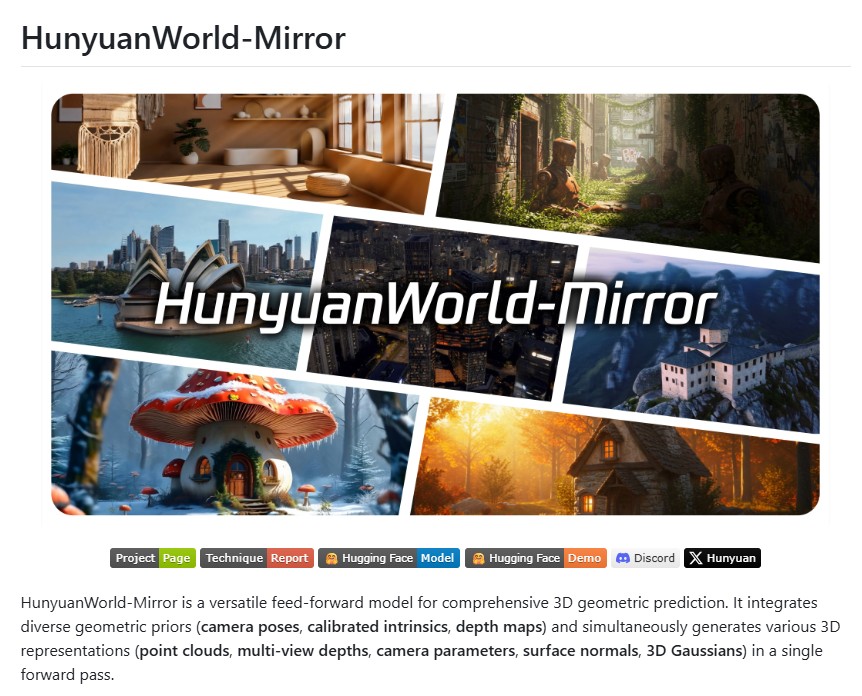The race toward achieving universal 3D understanding has reached a significant milestone with Tencent’s HunyuanWorld-Mirror, a cutting-edge open-source model designed to revolutionize 3D reconstruction. In an era dominated by visual intelligence and immersive digital experiences, this new model stands out by offering a feed-forward, geometry-aware framework that can predict multiple 3D outputs in a single pass.

Unlike traditional 3D reconstruction methods that depend on task-specific networks or multi-stage optimization, HunyuanWorld-Mirror provides a comprehensive solution for geometric prediction. It integrates diverse geometric priors such as camera poses, intrinsics, and depth maps and outputs multiple 3D representations including point clouds, surface normals and 3D Gaussian splatting.
This capability positions HunyuanWorld-Mirror as one of the most versatile and efficient 3D reconstruction models available, setting a new standard for AI-driven world modeling.
The Vision Behind HunyuanWorld-Mirror
Developed by Tencent Hunyuan, the project aims to bridge the gap between fast inference and high-fidelity 3D geometry generation. The model is designed for a broad range of 3D vision tasks – scene reconstruction, novel view synthesis, and geometry estimation making it valuable for AR/VR, robotics, simulation, digital twins and AI-generated content (AIGC) applications.
Its architecture emphasizes two major innovations:
- Multi-Modal Prior Prompting
HunyuanWorld-Mirror can take in diverse priors, such as camera poses, calibrated intrinsics and depth information. These priors are embedded as structured tokens through lightweight encoding layers. The model can operate with any combination of these priors ensuring flexibility across different datasets and hardware setups. - Universal Geometric Prediction
At its core, HunyuanWorld-Mirror unifies multiple geometric prediction tasks into a single framework. This design allows it to handle a wide range of 3D reconstruction challenges from point cloud regression and surface normal estimation to multi-view depth synthesis and camera parameter prediction without switching between specialized models.
Installation and Setup
Tencent provides a straightforward installation process that supports Windows and Linux with CUDA 12.4 recommended for optimal performance.
The model runs on PyTorch 2.4.0 with dependencies easily installed through conda and pip. Users can also take advantage of Gradio integration to quickly launch a web-based demo for local or online experimentation.
The repository, available on GitHub also includes an inference script (infer.py) and pretrained weights hosted on Hugging Face making it accessible to both developers and researchers.
Key Features of HunyuanWorld-Mirror
1. Comprehensive 3D Prediction
HunyuanWorld-Mirror generates multiple geometric outputs simultaneously, including:
- Depth maps
- Surface normals
- Point clouds
- Camera poses and intrinsics
- 3D Gaussian splatting representations
This integration allows developers to run end-to-end 3D reconstruction in a single forward pass reducing complexity and computational cost.
2. Support for Multiple Priors
The model can utilize various combinations of geometric priors. Whether working with partial information (such as depth-only input) or full priors (camera poses, intrinsics and depth), HunyuanWorld-Mirror adapts its inference to deliver optimized results.
3. Cross-Platform Flexibility
With explicit support for Windows, Linux, and CUDA 12.4 environments, the model ensures broad accessibility. The demo setup through Gradio enables quick local visualization and outputs can be exported to COLMAP format for downstream optimization.
4. Integration with 3D Gaussian Splatting
Through the gsplat module, HunyuanWorld-Mirror allows real-time rendering and visualization of reconstructed 3D scenes using Gaussian splatting – a modern approach for high-quality point-based rendering.
Performance Benchmarks
The performance of HunyuanWorld-Mirror has been rigorously evaluated across standard 3D reconstruction benchmarks such as 7-Scenes, NRGBD, DTU, Re10K, and DL3DV.
Point Cloud Reconstruction
Compared with leading methods like Fast3R, CUT3R, VGGT and π³, HunyuanWorld-Mirror consistently achieves the lowest reconstruction errors (lower is better).
For example, on the 7-Scenes dataset, the model achieves an accuracy of 0.043 and completeness of 0.049, outperforming previous approaches. When all priors are integrated, accuracy improves dramatically to 0.018, showcasing the power of multi-prior conditioning.
Novel View Synthesis
In novel view generation, the model demonstrates superior visual quality achieving PSNR scores above 22 and SSIM scores around 0.77 when camera poses and intrinsics are included. This indicates that the model not only reconstructs accurate geometry but also renders photorealistic scenes from new perspectives.
Inference and Optimization
Running inference is straightforward. Users can load sequences of images, optionally add priors (camera pose, intrinsics, depth), and obtain predicted 3D outputs in a single step.
For users seeking refined accuracy, HunyuanWorld-Mirror supports post-optimization with 3D Gaussian Splatting and COLMAP. This enables fine-tuning of 3D geometry, rendering improvements and integration with existing 3D pipelines.
Outputs include point clouds, depth maps, surface normals and 3D Gaussian files that can be visualized or exported for further processing.
Open-Source and Research Impact
Tencent Hunyuan has released HunyuanWorld-Mirror under an open-source license, inviting researchers and developers to contribute, extend, and apply the model across diverse 3D domains. The upcoming release of training code and evaluation tools will further empower the research community to explore novel ideas in feed-forward 3D modeling.
The project also acknowledges prior works such as VGGT, Fast3R and CUT3R building upon their foundations while delivering a unified and efficient framework.
For citation, the team has published the technical report titled “WorldMirror: Universal 3D World Reconstruction with Any-Prior Prompting” (Liu et al., 2025).
Conclusion: A Leap Forward in Universal 3D Reconstruction
HunyuanWorld-Mirror represents a pivotal advancement in 3D AI technology. By unifying geometry prediction tasks under one versatile architecture and enabling efficient feed-forward reconstruction, Tencent has set a new benchmark for the field.
This model bridges academic research and real-world application, offering high performance, flexibility, and accessibility. Whether used for robotics, AR/VR development, digital content creation, or scientific visualization, HunyuanWorld-Mirror provides the foundational tools for understanding and recreating the 3D world with unprecedented accuracy.
As Tencent continues to expand the open-source ecosystem around HunyuanWorld-Mirror, it signals a future where 3D perception is fast, flexible, and universally accessible empowering developers and researchers to build the next generation of intelligent 3D systems.
Follow us for cutting-edge updates in AI & explore the world of LLMs, deep learning, NLP and AI agents with us.
Related Reads
- MiniMax-M2: The Open-Source Revolution Powering Coding and Agentic Intelligence
- MLOps Basics: A Complete Guide to Building, Deploying and Monitoring Machine Learning Models
- Reflex: Build Full-Stack Web Apps in Pure Python — Fast, Flexible and Powerful
- Wren AI: Transforming Business Intelligence with Generative AI
- Google’s GenAI MCP Toolbox for Databases: Transforming AI-Powered Data Management

2 thoughts on “HunyuanWorld-Mirror: Tencent’s Breakthrough in Universal 3D Reconstruction”